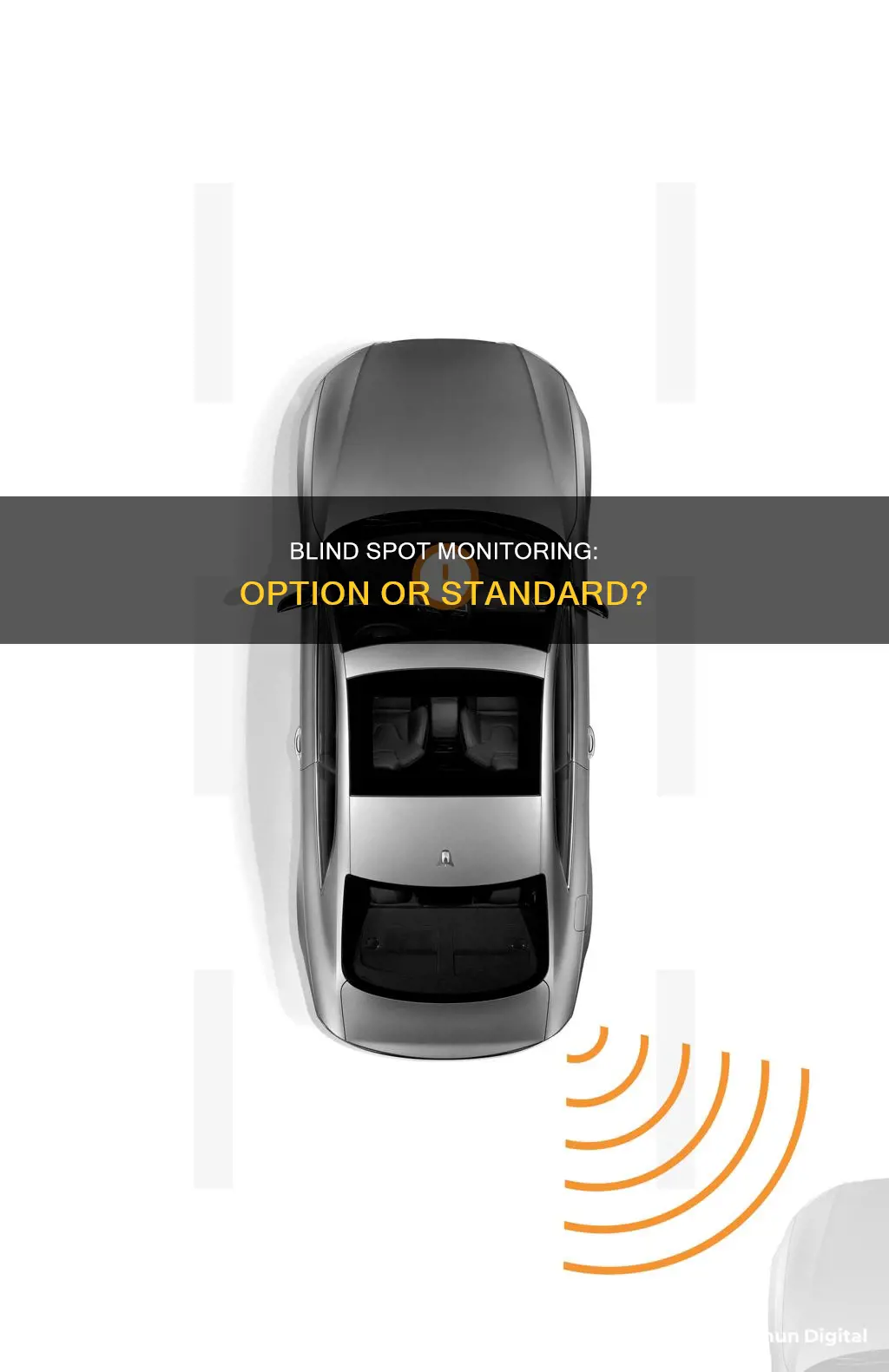
Blind-spot monitoring is a vehicle-based sensor device that detects other vehicles located in a driver's blind spot. It is designed to alert the driver of potential dangers when changing lanes or merging, and can be a valuable safety feature for preventing accidents and increasing driver awareness. While it is not currently mandatory, blind-spot monitoring is available as either a standard feature or an optional upgrade across a range of vehicles, from luxury cars to more affordable options.
| Characteristics | Values |
|---|---|
| Purpose | Alert the driver about vehicles in their blind spots |
| Alert Types | Visual, audible, vibrating, tactile |
| Sensors | Radar, ultrasonic, cameras |
| Sensor Locations | Side mirrors, rear bumper, side of the vehicle, rear quarter panels |
| Alert Locations | Side mirrors, A-pillar, driver-information display, head-up display |
| Active Safety | Steering assistance, automatic emergency steering, automatic braking |
| Bundled Features | Rear cross-traffic alert, lane-change assist |
| Availability | Standard or optional, depending on the vehicle |
What You'll Learn

How does blind-spot monitoring work?
Blind-spot monitoring (BSM) is a vehicle-based sensor device that detects other vehicles located in a driver's blind spot, i.e., in the space just off the rear quarter areas of your vehicle. Blind spots can hide a vehicle approaching in an adjacent lane, and many drivers improperly set their car's outboard mirrors, so merging into that lane often results in a crash. Blind-spot monitoring systems use sensors on the outside of the car to keep an eye on your blind spot.
The least sophisticated examples use radar or ultrasonic sensors embedded in each side of the vehicle's rear bumper. These sensors detect a vehicle approaching the rear of your car in an adjoining lane. More sophisticated BSM systems also employ side-mounted cameras. When BSM recognises a vehicle about to enter a blind spot, it warns you that a particular adjoining lane is not clear. The alert comes in the form of a yellow warning light on the outboard rearview mirror on the side of the oncoming car. It may also appear on your vehicle's A-pillar (the pillar between the windshield and either the front door), the driver-information display, or the head-up display. Some brands, such as Honda and Kia, provide an audible alert in some models. Often, audible alerts will sound if you use your turn signal, indicating you will merge into an occupied lane.
Advanced BSM versions will nudge you away from the lane marker on that side. The system may even steer you back to the centre of the lane. These advanced systems accomplish this through steering or by applying brake pressure to one or more wheels.
Blind-spot monitoring is not a replacement for turning your head to check your blind spot. However, it can help keep an eye on those spots that are hard to see with your mirrors. It is also statistically proven to reduce injuries caused by lane-change crashes.
Monitoring Internet Usage: A Guide to Tracking Your Data
You may want to see also

Which vehicles have blind-spot monitoring?
Blind-spot monitoring (BSM) is a vehicle-based sensor device that detects other vehicles located in a driver's blind spot, i.e., the space just off the rear quarter areas of your vehicle. This technology is designed to prevent crashes that occur when drivers merge into an adjacent lane, unaware that another vehicle is approaching.
Blind-spot monitoring is now offered across the market, from economy cars to luxury vehicles. Here is a list of vehicles that have blind-spot monitoring:
- Nissan Kicks S: BSM is standard on this model and costs $19,500.
- Kia Forte LXS: BSM is available with the $500 Technology Package for the $19,590 model.
- Ford F-150: BSM is available as standard or as an option and can be extended to monitor towed trailers.
- Ram 1500: Like the Ford F-150, the Ram 1500 offers BSM as standard or optional, which can also monitor towed trailers.
- Volvo S80: Volvo was the first manufacturer to offer BSM with its Blind Spot Information System (BLIS) for the S80 in 2005.
- Volvo XC90: BSM was introduced on this model in 2003, producing a visible alert when a car entered the blind spot.
- Mazda: Mazda was the first Japanese automaker to offer BSM, introducing it on the 2008 Mazda CX-9 Grand Touring. BSM has since been added to the Mazda2, Mazda3, CX-3, CX-5, MX-5 Miata, and CX-30.
- Ford: Ford uses the acronym BLIS for its BSM system, which was introduced in 2009 on the 2010 Ford Fusion and Fusion Hybrid, 2010 Mercury Milan and Milan Hybrid, and 2010 Lincoln MKZ.
- Mitsubishi Pajero Sport: This model, launched in 2016, offers a Blind Spot Warning (BSW).
- Nissan Fuga/Infiniti M: This model, introduced in 2010, was the first to offer countersteering capabilities to prevent collisions.
- Hyundai Genesis: The 2016 model offers a blind spot warning system as an optional feature.
- Mazda Mazda3: The 2016 model includes BSM as an add-on feature.
- Chevrolet Cruze: The 2016 model offers BSM as an optional feature.
- Mercedes-Benz E-Class: The 2016 model offers BSM as an optional feature.
- Ford Focus: The 2016 model includes BSM as an optional feature in a technology package.
- Honda Fit: The 2016 model offers Honda's LaneWatch blind spot camera monitoring system as an optional feature.
- Volvo S60: The 2016 model includes BSM as standard.
- Dodge Charger: The 2016 model offers BSM as an optional feature.
- Nissan Maxima: The 2016 model includes BSM as an optional feature.
- Cadillac ATS: The 2016 model offers BSM as an optional feature.
Qnix Monitors: Which One Should You Choose?
You may want to see also

Is blind-spot monitoring worth it?
Blind-spot monitoring (BSM) is a vehicle-based sensor device that detects other vehicles located in a driver's blind spot, i.e., the space just off the rear quarter areas of your vehicle. Blind spots can hide vehicles approaching in an adjacent lane, and according to the National Highway Traffic Safety Administration (NHTSA), roughly 9% of all reported vehicle crashes each year result from changing lanes or merging.
BSM systems use sensors, cameras, ultrasonic sensors, and/or radars to detect vehicles, objects, or pedestrians in a car's blind spot and alert the driver through visual, audible, or tactile warnings. Some BSM systems also provide steering or braking assistance to avoid a collision.
BSM was once only found in high-end luxury cars, but as the cost of the technology has decreased, it is now offered as a standard feature or option across the market, including in economy cars, trucks, and SUVs. For example, it's standard on the $19,500 Nissan Kicks S and comes with the $500 Technology Package for the $19,590 Kia Forte LXS.
While BSM is not mandatory, it is one of the most useful tools for keeping drivers safe and can be especially helpful for larger vehicles with bigger blind spots. BSM systems with collision prevention functionality add further value as they actively steer or brake, providing an additional layer of security.
If you're buying a new car, you'll likely come across BSM as a standard feature or on the options list. The decision to opt for BSM depends on various factors, including the size of your car, the efficiency of your vehicle's visibility, and your budget. While some drivers may not see the need for BSM, it can be a valuable safety feature, especially when paired with other safety technologies like rear cross-traffic alerts.
Monitoring Page File Usage: A Comprehensive Guide
You may want to see also

How much does blind-spot monitoring cost?
Blind-spot monitoring (BSM) is a vehicle-based sensor device that detects other vehicles located in a driver's blind spot. It is an active driver aid/safety device that warns the driver of vehicles approaching in an adjoining lane.
The cost of a blind-spot monitoring system depends on its functionality and technical parameters. Basic systems can be purchased for as little as $100, while more advanced systems with features such as a buzzer alarm system, extra mirrors, or a built-in camera system can range from $150 to $750.
Aftermarket blind-spot monitoring kits are also available for older vehicles, with solid systems costing around $300 to $500. The installation of these kits can cost at least $200, depending on the complexity of the system and the location.
Overall, the cost of a blind-spot monitoring system can vary from $100 to $750 or more, depending on the features and specifications.
Ram Trucks: Blind Spot Monitor Feature Explained
You may want to see also

What are the drawbacks of blind-spot monitoring?
Blind-spot monitoring (BSM) is a vehicle-based sensor device that detects other vehicles located in the driver's side and rear blind spots. It is designed to alert the driver of approaching vehicles in adjacent lanes, usually through visual, audible, vibrating, or tactile warnings. While BSM is a valuable safety feature, it has some drawbacks.
One significant drawback of BSM is its difficulty in detecting fast-moving vehicles. Studies have shown that BSM systems often alert drivers too late of an approaching vehicle in the adjacent lane, which can be problematic when merging onto busy highways. This delay in detection may be due to the system's reliance on visual cues in the driver's side mirror, which can be affected by external factors such as bright lights.
Another drawback of BSM is that it may not always provide audio cues to indicate a vehicle in the blind spot unless the turn signal is activated. This means that if a driver does not use their turn signal, they may miss an audio warning, potentially leading to a missed alert.
Additionally, BSM systems may not be as effective for motorcyclists. Research has found that motorcycles were detected 26% later than passenger vehicles, indicating a potential delay in warning for drivers sharing the road with motorcycles.
While BSM can be a valuable safety feature, it is not a substitute for proper mirror adjustment and checking blind spots. Untrained drivers who rely solely on BSM without correctly setting up their mirrors may still miss vehicles in adjacent lanes.
Furthermore, BSM systems are not 100% reliable and can sometimes give false alarms. For example, the system may mistake a vehicle passing through a tunnel wall as an approaching vehicle, leading to unnecessary warnings.
In conclusion, while BSM offers many benefits, it is important to be aware of its limitations. Drivers should continue to follow best practices, such as properly adjusting mirrors, checking blind spots, and remaining vigilant while driving, even with BSM systems in place.
White Pages Premium: Does It Keep Your Monitoring Anonymous?
You may want to see also
Frequently asked questions
Blind-spot monitoring (BSM) is a vehicle-based sensor device that detects other vehicles located to the driver’s side and rear. It alerts the driver through visual, audible, vibrating, or tactile cues.
Blind-spot monitoring uses sensors, cameras, or radar technology to detect vehicles in a car's blind spot. When a vehicle is detected, the driver is alerted through lights, beeps, or other warning signals.
No, blind-spot monitoring is not standard in all vehicles. While it is becoming more common, it is often offered as an optional upgrade or included in higher trim packages. However, some vehicles, such as the Hyundai Elantra, Kia Forte, and Nissan Sentra, offer it as standard equipment.
Blind-spot monitoring enhances safety by providing drivers with additional information about their surroundings. It helps prevent accidents, injuries, and costly repairs by warning drivers about potential hazards in their blind spots. It also reduces the driver's workload by eliminating the need for frequent head turns to check blind spots.
One drawback of blind-spot monitoring is its limited effectiveness in detecting fast-moving vehicles or motorcycles. Studies have found that the system may provide alerts too late for the driver to take action, especially when merging onto busy highways. Additionally, external factors such as bright lights can interfere with the driver's ability to notice visual cues.







